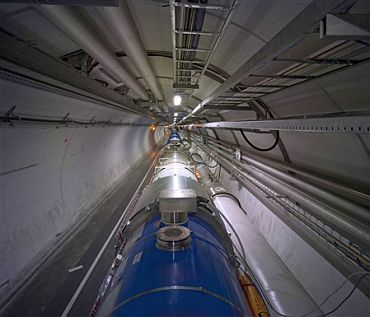 Physicists at the European Organisation for Nuclear Research broke a record with their atom smasher Large Hadron Collider when they managed to collide protons at 3 times the energy previously achieved.
Physicists at the European Organisation for Nuclear Research broke a record with their atom smasher Large Hadron Collider when they managed to collide protons at 3 times the energy previously achieved.
Earlier in the day, scientists stepped up efforts to detect the elusive 'God Particle' by triggering collision of two proton beams in the world's largest atom smasher located on the Franco-Swiss border on the outskirts of Geneva.
The two proton beams, set in motion in opposite directions of two 27-km long pipes of the LHC in November last year, were previously moving at 3.5 trillion electron volts (TeV) with each beam of the protons going around the device 11,000 times every second.
Physicists achieved the feat while attempting to collide the two beams at 7 TeV, creating conditions similar at the time of the Big Bang -- that is believed to have created the universe.
Indian scientists joined their counterparts from across the world, who observed the collisions as they happened.
When the proton beams collided, 800 million collisions per second took place and powerful detectors installed at the site gathered data of each of the collisions.
The analysis of this data that could lead to the discovery of the Higgs boson, also called as the 'God particle', that is believed to have existed when the universe was born, said Prof Satyaki Bhattacharya of Delhi University who is involved in the LHC experiment.
Researchers will sift through the subatomic debris of proton collisions for signs of extra dimensions that will bolster belief in "supersymmetry", a theory that doubles the number of particle species in the universe.
The LHC is designed to collide two 7 TeV proton beams, but scientists decided in January to operate the machine at half the power until the end of 2011. The machine will then close for a year of further engineering work to ensure it can run at full power in 2013 without breaking down again.
For scientists at CERN and elsewhere, the beginning of high-energy collisions will end a long period of working without any real data. Until recently, many physicists have had to make do with computer simulations of particle collisions.
CERN researchers will sift through the subatomic debris of proton collisions for signs of extra dimensions and hitherto invisible particles that will bolster belief in "supersymmetry", a theory that doubles the number of particle species in the universe. Other results may point to "hidden worlds" of particles and forces that we are oblivious to because they do not interact with everyday matter.
Much higher energy collisions take place constantly in nature, when particles in cosmic rays slam into clouds of interstellar gas, heavenly bodies and ions in the Earth's atmosphere.
The LHC is expected to make new discoveries about the laws of physics at the highest energies and smallest scales ever probed.
CERN Director General Rolf Heuer said scientists hope by the end of this year to make discoveries into the mysterious dark matter that they believe comprises a quarter of the whole universe. The better understood visible universe makes up only five per cent of the universe.
Dark matter has been theorised by scientists to account for missing mass and bent light in faraway galaxies. They believe it makes galaxies spin faster. A separate entity called 'dark energy' makes up the remaining 70 per cent of the universe, and this is understood to be associated with the vacuum that is evenly distributed in space and time. It is believed to accelerate the expansion of the universe.







